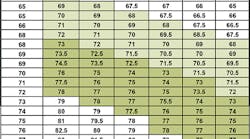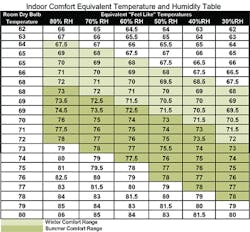During summer months, high humidity makes air feel warmer than the temperature displayed on a thermostat. If this principle holds true during the cooling season, could higher humidity make the air feel warmer during winter months? Let’s take a look at the effects of humidity, how it changes the feel of air, and what you can do to increase comfort by controlling it better.
Hygrometers Now Better and Cheaper
One test instrument, called a hygrometer, is used to measure and diagnose humidity issues. Once I found a 150-year-old humidity measurement instrument in an 800-year old shop in England. Rolled up in a large envelope was the instrument’s sensing media; Human Hair. Control manufacturer’s used horsehair to sense humidity changes until the 1970s.
How many of you remember swinging a sling psychrometer to measure humidity? This old friend has slipped into history: it just can’t read accurately enough to provide the critical readings we need today.
Twenty years ago, a reasonably accurate hygrometer cost more than $2000. Today, reliable hygrometers are available for less than $150. To find a hygrometer that will do the job, look for one that measures from 5% to 95% relative humidity (RH) and has a readout to the tenth of a percent or degree. Most hygrometers now measure humidity, dry and wet bulb temperatures, relative humidity, and enthalpy.
Ideal Temperature and Humidity
Ideal indoor humidity levels vary in different climate zones and according to the age of your customer. Study Figure 1: Indoor Comfort Equivalent Temperature and Humidity Table to see how an increase in humidity will help a home “feel warmer” during winter months.
Notice the data across the 70º row. Seventy-degree air at 80% RH, feels like 76º. Seventy-degree air at 30% RH, feels like 70.5º. That’s a 5.5º difference in temperature feeling due to changes in the humidity level!
ASHRAE Standards specify ideal comfort ranges of 68º to 74º at 40% to 60% relative humidity in the winter months and 73º to 79º at 40% to 60% relative humidity in the summer months.
How to Measure and Compare Humidity and Temperature
To effectively evaluate current indoor conditions, you’ll need to measure room relative humidity and temperature.
To do this, allow the room to stabilize with the system running for at least 15 minutes. Set your hygrometer to display in humidity mode, then simply take the readings.
Do not measure near a wall or heat-generating appliances. Also, don’t take a measurement in the supply register airstream or directly in the sun. Do measure humidity near the center of the room. Take temperature readings using the same test procedure, just press the button to display in temperature mode.
Take and record humidity and temperature in several typical rooms served by the same system. Then average the humidity and temperature measurements. If a room varies more than 3% from other rooms, search for the source of high or low humidity and temperature.
Compare the average building temperature to industry temperature and humidity standards. Most importantly, compare what you measured to what your customers desire. Then figure out how to make the needed changes.
Building Performance and Moisture
When building humidity is low, find an opportunity to add humidity. When building humidity is high, you’ll an opportunity to remove humidity.
Normally, you add humidity by installing humidifiers. You can reduce humidity by lowering airflow. This increases humidity removal at the cooling coil. Another option is to add dehumidification to the building.
On occasion and especially in humid regions, you must control humidity by reaching outside the HVAC system and eliminating the problem at the building level.
Unwanted moisture may enter or exit through roof and wall leaks. Moisture may seep into a building from surface water, rain, or landscape irrigation. Moisture may also enter a building from water vapor in soil that may wick or migrate inside.
Internal sources of moisture include leaks from plumbing systems, or water vapor from showers, cooking, laundry, or plants.
The best solution to excessive moisture is to not allow it to enter a building in the first place. Once moisture enters a building, it requires significant cost and energy to remove it.
HVAC Systems May Cause High or Low Humidity
When it comes to discovering sources of high or low humidity in a building, most of us are surprised to find that HVAC systems are the force driving the problem.
In winter months, return duct leaks in the attic create a positive pressure in the building because supply cfm exceeds return cfm. This condition forces warm air carrying humidity out of building openings, further reducing humidity levels which are typically lower in winter months.
Return air leakage from unconditioned attics may be the worst source of added moisture in summer months. A 200 cfm return leak from a 120°F attic can easily raise the humidity in a home by 30% in several hours if humidity is high outdoors.
Supply duct leaks can also create moisture problems. When supply ducts are outside the building envelope and they leak, the amount of supply air may be less than the amount of return air in a building. This will cause negative pressure inside the building.
When buildings operate under negative pressure, moisture will be pulled inside whenever the fan is operating. This is especially true in the more humid regions of the country. Some building humidity levels are constantly high due to this effect.
Your opportunity; fix duct leaks and eliminate moisture movement into and out of buildings.
Change Equipment Latent Capacity
In cooling mode, system humidity removal may be increased by lowering the airflow over the cooling coil. Lower airflow decreases the coil temperature. A cooler coil temperature forces return air to shed its moisture before it can transfer its heat to the coil.
Many contractors are increasingly lowering indoor humidity in the more humid parts of the country by adding dehumidification systems. Stand-alone equipment or auxiliary dehumidification equipment is often required to maintain acceptable humidity levels, even when the system is operating at near-perfect performance.
Humidification
In winter months, many parts of the country require moisture to be added to maintain comfortable humidity levels.
As air is heated, moisture is removed through the combustion process. Also, when it is cold and dry outside and the building envelope is leaky, physics takes over. Warm air moves toward colder air and takes the humidity with it. This leaves an uncomfortably dry home that begs for a moisture infusion.
Once you verify that the HVAC system and building are both operating as correctly as possible, the next option is to add auxiliary humidification or humidity removal equipment, as needed, to address moisture issues. Whatever your customers may need, applying your growing knowledge to provide comfort will keep your services in demand.
Rob “Doc” Falke serves the industry as president of National Comfort Institute, Inc., an HVAC-based training company and membership organization. If you're an HVAC contractor or technician interested in a free test procedure on how to measure temperature and humidity, contact Doc at [email protected] or call him at 800-633-7058. Go to NCI’s website at nationalcomfortinstitute.com for free information, articles, and downloads.










